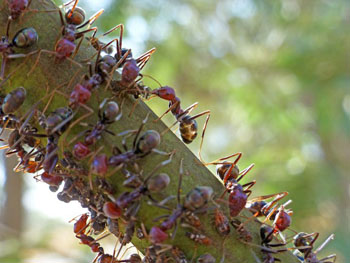Ant Antennae Communicate Vital Social ID Information
By LabMedica International staff writers
Posted on 05 Apr 2016
Scientists have shone new light on the complexities of insect communication with the discovery that ants not only pick up information through their antennae, but also use them to convey social signals. The report is the first showing ant antennae to function as a two-way chemical communication device, rather than only as a receptor.Posted on 05 Apr 2016
Biologists from University of Melbourne (Melbourne, Australia) analyzed the behavior and surface chemistry of hundreds of ants to examine how they interacted. The key focus was on cuticular hydrocarbons (CHCs)—a layer of waxy build-up that covers the body of many insects, including ants, bees, wasps, flies, and beetles. CHCs are a group of multi-purpose chemical compounds that not only protect animals from dehydration, but also form a crucial part of their communication toolbox. For example, ants use CHCs to identify other ants as friends or foes.

Image: Scientists had viewed ant antennae as being used only to receive information – new research has demonstrated that they also transmit critical social signals (Photo courtesy of the University of Melbourne).
In the new research, when the CHCs were removed from just the antennae of one species of ants, opponents (other ant species) were no longer able to recognize colony identity, indicating that antennae CHCs provide information about which nest an ant comes from.
"An ant's antennae are their chief sensory organs, but until now we never knew that they could also be used to send out information," said Qike Wang, PhD student.
Over 125 years ago, famed entomologist Auguste Forel removed the antennae of four species of ants and put the ants together. Instead of fighting, they unnaturally huddled together peacefully. "Forel’s experiment told us about antennae being used to receive chemical signals, but our research suggests that they are also a source of chemical signals,” added Mr. Wang, "Like everyone else, we assumed that antennae were just receptors, but nature can still surprise us."
The researchers also found that CHC profiles were different depending on where on the body they were. This contradicts the conventional wisdom that CHC profiles on different body parts of ants are the same. “Compared to visual or acoustic signals, we know rather less about chemical signals, and one reason might be that we are analyzing a mixture of different signals,” said Mr. Wang.
The study, by Wang Q et al., was published March 30, 2016, in the journal Proceedings of the Royal Society of London B.
Related Links:
University of Melbourne













